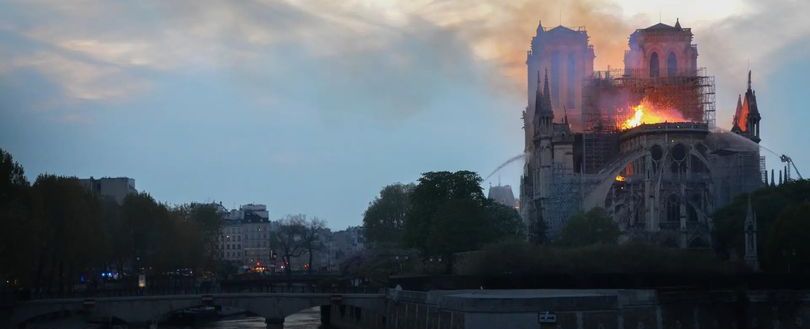- Homepage
- News
- Blogs & Articles
- On this day, forgotten disasters: Notre Dame de Paris fire

On this day, forgotten disasters: Notre Dame de Paris fire
Like it? Share it!
15 April 2024 by FIA Team, FIA Team
On April 15th, 2019, Notre Dame de Paris, a medieval Gothic Catholic cathedral situated in the centre of Paris, renowned globally as a The United Nations Educational, Scientific and Cultural Organization (UNESCO) world heritage site for its architecture and invaluable collection of art, tragically witnessed a devastating fire. The intensity of the fire led to the collapse of certain sections of the cathedral's upper structure. It is believed to have started under the eaves of the cathedral roof, engulfing the spire and most of the roof. Alarm bells activated at approximately 18:30, with the priest pausing the evening’s service of Mass. No signs of fire were discovered at this time following an initial investigation, but the cathedral was evacuated as a precautionary measure. A secondary activation at approximately 18:45 saw the fire declared, where it rapidly spread throughout the roof areas sending smoke, lead and other toxic gasses billowing into the Parisian sky, affecting the city’s landscape.
Despite the swift mobilisation of 400 fire and rescue services arriving on site, the fire had already taken hold, leading to the catastrophic collapse of the spire, which fell through the cathedral roof below. Due to the sensitive construction and contents within the building, the fire fighting approach was fought from within the building in order to avoid high pressure hose jets causing further damage to the structure and also deflecting flames and hot gasses further inward to the structure. This also precluded the use of aerial fire fighting.
Fortunately, due to such a swift response by emergency services, the fire was finally brought under control and extinguished, nine hours later. Although most of the roof and the spire were destroyed, most of the building was able to be saved. This swift reaction was also invaluable in being able to save many of the valuable artworks and irreplaceable artefacts by having them moved to safety, by emergency service personnel and other workers.
4 days after the fire, President Emmanuel Macron set an ambitious five-year deadline for restoration, a goal that has garnered substantial support with over €840 million contributed by donors from across the world by September 2021. While the cathedral is expected to reopen some areas by December 2024, the complete restoration may extend over the next several decades.
The 12th-century cathedral's deteriorating stonework and dry rotting timbers, coupled with the risks posed by ongoing restoration work, presented an increased risk of fire, and provided a source of fuel once the fire had ignited, making an already challenging situation that much more difficult for the fire and rescue services.
Official investigations and an inquiry are still ongoing by the office of the Paris prosecutor, with very little information from their initial, and ongoing findings being reported to official sources, except that there was no evidence of the fire being a deliberate act. Initial investigations into the fire are believed to have considered multiple theories, including potential ignition from either a cigarette, a short circuit in the electrical system, or hot works as part of the ongoing construction works. An official cause has yet to be reached by investigators, but due to the damage sustained to the building, and also the fact that the fire damaged much of the evidence, it has been reported that a conclusive cause may never be found.
The risk of a fire event within the Notre Dame had previously been acknowledged, yet the speed at which it spread had been underestimated, highlighting critical gaps in safety assessments. The fire and rescue services regularly carried out on-site training exercises, and practised for emergencies within the cathedral, even having a serving firefighter posted to the site each day.
It is reported however that the management procedures and training on site were lacking, with a poorly labelled fire detection and fire alarm system causing confusion as to the area of activation. When a guard was sent to investigate, it was some 15 minutes later before it was realised that the guard had been sent to the wrong location. By the time the guard had climbed the 300 steps to the cathedral roof space, the fire had already taken hold. The fire detection and fire alarm system had not been designed to include remote monitoring to an alarm receiving centre, which by the time the guard had returned from the roof space, further delayed the arrival of the fire and rescue service.
The above failures highlight the need for comprehensive training and clear communication between staff in emergencies, whilst prompting a reassessment of emergency preparedness, training protocols, and risk mitigation strategies. Had there been automatic transmission of fire signals to the fire and rescue service, the time between the ignition and the arrival of firefighters could have been reduced, allowing them to be on site quicker to minimise the risk to persons, and to further prevent catastrophic damage to the building.
As we reflect on this forgotten disaster, the Notre Dame de Paris fire holds valuable insights that can reshape fire safety practices and allow us to learn from past mistakes to further safeguard our heritage and ensure the safety of such buildings for the enjoyment of future generations.
View the SOURCE here.
Image SOURCE here.
-
FIA Team
FIA Team
Related posts
-
Fireside Chat with Head of Special Risks and Fire Services at Mitie Security, Andrew Lewis
22 August 2025
By Charlotte Brill, Content Marketing Executive
-
Fireside Chat with the Portables Product Manager at Chubb Fire and Security, Guy Middleton
24 October 2024
By Charlotte Brill, Content Marketing Executive
